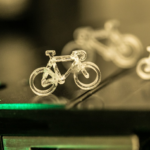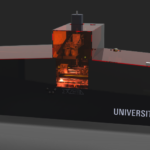

In the recently published ‘3D printing on glass for direct sensor integration,’ authors M. Neubauer, M. McGlennen, S. Thomas and S. Warnat explore further methods for refining 3D printed microfluidics. In this study, the researchers create an approach for fabricating channels onto glass substrates.
As additive manufacturing processes become a realistic method for fabricating fluidic devices, using vat polymerization ( they abbreviate it VPP), stereolithography (SLA), and digital light processing (DLP), researchers have many different options before them for research like integration of sensors. Glass substrates offer a way for making channels that are not only optically transparent but offer a way to embed a glass-based impedance-conductivity sensor within the 3D printed flow channel.
For the 3D printing process, the researchers chose a MiiCraft 50, along with clear BV007 resin.
“Using a silicone gasket and a diaphragm vacuum pump (Masis, GZ35-12) a glass slide could be held in place during the printing process and quickly released afterwards. The glass slide protruded slightly from the plane of the build plate; this distance was measured and accounted for in the printer software,” explained the researchers.

“Mounting the glass flush with the edge of the insert made it possible to reference the edge of the glass in the software so that prints could be precisely aligned to the edges of the glass itself with better than 100 μm repeatability.”
The research team selected sample applications to match the sensors, but they could also be used in a wide range of applications. The build plate, silane treatment, and more, could be used with other hardware and materials.
“The glass substrate is itself a part of the channel and allows ideal optical access. Resistance measurements, Raman spectroscopy, and impedance spectra show that sensor properties are unaffected, and no resin or chemicals are left on the sensing surface after printing on the sensor. Viability of materials other than Au could be tested for other applications with similar techniques,” concluded the researchers.
“Applying the same methods for device realization, any number of devices can be integrating with a 3D printed structure. The limitations on device design generally are associated with the 3D printer, its resolution and compatible resins. These issues will become less prevalent as the technology in this rapidly advancing field improves and becomes available. Overall, this process will benefit from all advances in 3D printing technologies, becoming an increasingly viable avenue for sensor-packaging integration for bio-sensing.”
3D printing microfluidics is becoming an extensive area of study, from analyzing and solving challenges within to exploring the connection with other materials and processes, to include bioprinting. What do you think of this news? Let us know your thoughts; join the discussion of this and other 3D printing topics at 3DPrintBoard.com.
[Source / Images: ‘3D printing on glass for direct sensor integration’]
If you're looking to get architectural 3D animation in the USA, our service provides an exceptional way to bring your architectural concepts to life through dynamic, immersive visuals. Through our platform, you can easily request high-quality 3D animations that showcase your designs in motion, offering a detailed view of your project from multiple angles and perspectives. Whether it's for a real estate development, a commercial building, or an urban planning project, our expert team ensures that every detail is captured in a visually compelling animation.
Through our website, you can seamlessly get architectural 3D animation tailored to your project’s specific needs. With our help, you can offer potential clients or investors an engaging experience that goes beyond static images. By integrating CGI animations with real-world settings, lighting, and textures, our team creates a lifelike experience that allows your audience to interact with your project as though it were already built. This service is perfect for presenting complex designs in a clear, visually attractive way that stands out in the competitive architectural market.




